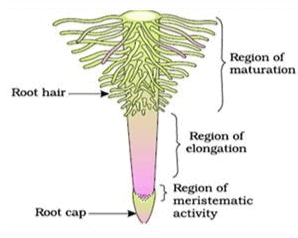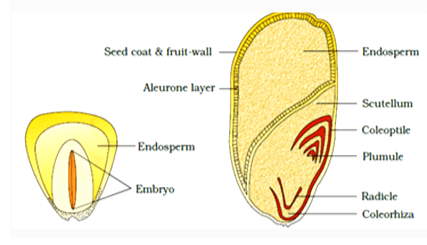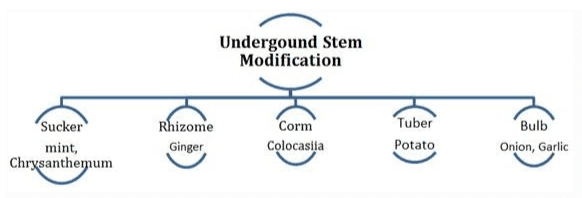NCERT Notes: Morphology of Flowering Plants | NCERTs at Fingertips: Textbooks, Tests & Solutions - NEET PDF Download
Morphology is the branch of biological science that deals with the study of form, size, colour, structure and relative position of various parts of organisms.
Importance of morphology
- Knowledge of morphology is essential for recognition or identification of plants.
- It gives information about the range of variations found in species.
- Deficiency and toxicity symptoms are morphological changes that occur in response to shortage or excess of minerals.
Parts of Flowering Plants
- All the flowering plants have roots, stem, leaves, flower and fruits. The underground parts of flowering plant are the root system and the portion above the ground forms the shoot system.
The Root
- In Dicotyledons, elongation of radicle forms the primary roots which bears lateral roots of several orders called secondary roots, tertiary roots, etc.
- Primary roots along with lateral roots forms the Tap root system.
Example: Mustard, Gram, etc. - In monocotyledons, primary root is replaced by large number of roots at its base of stem to constitute the Fibrous root system. Wheat, rice etc.
- The roots that arise from other parts of plant beside radicle are called adventitious roots.
Example- Grass, Banyan tree, Maize, etc. - The main function of root system are absorption of water and minerals from soil, providing proper anchorage to the plant parts and storing reserve food materials.
Regions of Roots

- The apex of root is covered by a thimble like structure called root cap, it protect the tender apex of root while making way through soil.
- Above the root cap is region of meristematic activity having small cells with dense cytoplasm.
- The part above the region of meristematic activity is region of elongation where cells under go elongation and enlargement to increase the length of root.
- Region of maturation contain root hairs that help in absorption of water and minerals.
Modification of roots- Roots are modified for storage, nitrogen fixation, aeration and support.
- Tap root of carrot, turnip and adventitious root of sweet potato get swollen to store food.
- Prop root of Banyan and Stilt root of maize and sugarcane have supporting root coming out from lower node of stems.
- In Rhizophora, Pneumatophores help to get oxygen for respiration as it grows in swampy areas.

The Stem
- It is the ascending part of axis bearing branches, leaves, flowers and fruits. It develops from Plumule of the embryo.
- Stem bears nodes and internodes. The region of stem where leaves are born are called nodes and portion between two nodes are called internodes.
- The main function of stem is spreading branches, bearing leaves, flowers and fruits. It also conducts water and minerals from root to leaves and product of photosynthesis.
- Some stem perform special functions like storage of food, support, protection and vegetative propagation.
Modification of stems
- Underground stem of potato, ginger and turmeric are modified to store food. They also act as organ of perennation in unfavorable conditions.
- Stem tendril help plants to climb as in cucumber, pumpkins, and grapes.
- Axillary buds of stem may modify into woody, straight and pointed thorns as in Citrus and Bougainvillea.
- Plants of arid regions modify their stem to flattened (Opuntia), fleshy cylindrical (Euphorbia) having chlorophyll for photosynthesis.

The Leaf
- Leaf is a green, dissimilar exogenous lateral flattened outgrowth which is borne on the node of a stem or its branches is specialized to perform photosynthesis.

- Leaves originate from shoot apical meristem and are arranged in an acropetal order.
- A typical leaf consists of three parts- Leaf base, Petiole, Lamina. Leaf is attached with stem by Leaf Base which may bear two small leaf like structure called stipule.
- Middle prominent vein is called mid vein. Veins provide rigidity to the leaf blade and act as channel for transport of water and minerals.
- The arrangement of vein and veinlets in the lamina is called venation.


- A leaf having a single or undivided lamina is called Simple leaf. The incisions do not touch the mid rib. Example- Mango, Guava etc.
- When the incision of lamina reach up to the midrib and breaking it into a number of leaflets, it is called Compound leaves.
- In a Pinnately compound leaves, a number of leaflets are present on common axis called rachis. Example- Neem.
- In Palmately compound leaves, the leaflets are attached at common point. Example- Silk cotton.
- The pattern of arrangement of leaves on the stem or branch is called Phyllotaxy.
- In alternate type of phyllotaxy single leaf arise at each node as in China rose.
- In opposite types of phyllotaxy a pair of leaves arise from each node opposite to each other as in Guava.
- If more than two leaves arise at a node and form a whorl is called whorled type of phyllotaxy as in Alstonia.
- Leaves are modified to perform other functions like converted to tendril for climbing as in Peas and spines for defence in Cactus.
Inflorescence
The arrangement of flowers on the floral axis is termed as inflorescence. Two main types of inflorescence are racemose and cymose.

The flower
- Flower is the reproductive part of angiospermic plants for sexual means of reproduction.
- A typical flower has four whorls arranged on a swollen end of stalk or pedicel called thalamus. They are Calyx, Corolla, Androecium and Gynoecium.
- When a flower has both androecium and gynoecium, the flower is called bisexual and flower having either androecium or gynoecium only is called unisexual.
- When flower can be divided into two equal radial halves in any radii passing through center the symmetry of flower is called actinomorphic (radial symmetry) as in Mustard, Datura, and Chili.
- When flower can be divided into two similar parts only in one vertical plane it is zygomorphic as in Pea, Gulmohar, Cassia etc.
- When Floral appendages are in multiple of 3,4 or 5 they are called trimerous, tetramerous and pentamerous respectively. Flower with bracts are called bracteates and without it ebracteate.
- Based on the position of ovary with respect to other floral part on thalamus, flowers are of following types:

- Hypogynous flower– Ovary occupies the highest position. The ovary in such case is called superior. Eg. Mustard, brinjal and china rose.
- Perigynous flowers- If the gynoecium is situated at the centre and other parts are on the rim at same height. Ovary is called half-inferior.
- Epigynous flowers- The margin of thalamus grows to completely cover the ovary. Ovary is said to be inferior.
Calyx is the outermost whorl of the flower; its members are called sepals. They are generally green and leafy; protect the flower in bud stage. It may be gamosepalous (sepals united) or polysepalous (sepals free).
Corolla consists of petals, brightly coloured to attract the insects for pollination. They may be gamopetalous or polypetalous.
- The mode of arrangement of sepals or petals in floral bud with respect to the other members of same whorl is called aestivation. In valvate, the whorls of sepals or petals touch each other as in Calotropis. In Twisted aestivation, the whorls overlap each other as in China rose.
- In Imbricate aestivation, margin overlap each other but not in particular fashion as in Gulmohur.
- In pea and bean flowers, there are five petals- the largest (standard) overlaps the two lateral petals (wings) which in turn overlap two smallest anterior petals (keel). This type of aestivation is known as vexillary or papilionaceous.

The Androecium
- Androecium represent the male reproductive parts of flower, consists of stamens. Each stamen consists of filament and anther. Pollen grains are produced in pollen sac. Sterile stamen is called Stemenode.
- When stamens are attached with petals it is called epipetalous (Brinjal). Stamen may be free (polyandrous) or may be united in one bundle (monoadelphous), two bundles (diadelphous), more than two (polyadelphous).
The Gynoecium
- Female reproductive part of flower consists of one or more carpels. Each carpel is made up of stigma style and ovary.
- When more than one carpel is present, it may be free (apocarpous) as in lotus and rose or fused together (syncarpous) as in mustard and tomato.
- After fertilisation, ovules change into seeds and ovary mature into fruits.
Placentation
- The arrangement of ovules within the ovary is called placentation.

The fruit
- Mature and ripened ovary developed after fertilisation is fruit. If a fruit is formed without fertilisation of ovary it is called parthenocarpic fruit.
- Fruit consists of seeds and pericarp. Thick and fleshy pericarp is three layered called epicarp, mesocarp and endocarp.

- Dicotyledonous Seed is made up of a seed coat and an embryo. Embryo is made up of embryonal axis, radicle and cotyledons.
- Seed coat has two layers outer testa and inner tegmen. Hilum is scar through which seed is attached to the ovary. Small pore above the hilum is called micropyle.

Monocotyledonous seeds

- In monocotyledonous seed, outer covering of endosperm separate the embryo by a proteinous layer called aleurone layer.
- Single cotyledon is called as scutellum having a short axis bearing Plumule and radicle.
- Plumule and radicle are closed inside sheaths called as coleoptile and coleorhiza respectively.
Semi -Technical Description of a Typical
Flowering Plant
The plant is described beginning with its habit, vegetative characters – roots, stem and leaves and then floral characters inflorescence and flower parts.
The floral formula is represented by some symbols. In the floral formula, Br stands for bracteate K stands for calyx , C for corolla, P for perianth, A for androecium and G for Gynoecium. Fusion is indicated by enclosing the figure within bracket and adhesion by a line drawn above the symbols of the floral parts.
Description of Some Important Families
Fabaceae
- This family was earlier called Papilonoideae, a subfamily of family Leguminosae.
- Vegetative Characters
- Trees, shrubs, herbs
- root with root nodules
- Stem: erect or climber
- Leaves: alternate, pinnately compound or simple; leaf base, pulvinate; stipulate; venation reticulate.
- Floral characters
- Inflorescence racemose
- Flower: bisexual, zygomorphic
- Calyx: sepals five, gamosepalous; imbricate aestivation
- Corolla: petals five, polypetalous, papilionaceous, consisting of a posterior standard, two lateral wings, two anterior ones forming a keel (enclosing stamens and pistil), vexillary aestivation
- Androecium: ten, diadelphous, anther dithecous
- Gynoecium: ovary superior, mono carpellary, unilocular with many ovules, style single
- Fruit: legume; seed: one to many, non-
- Economic importance: Many plants belonging to the family are sources of pulses like gram, arhar; edible oil like soyabean, groundnut; dye like indigofera; fibre like sunhemp; fodder like Sesbania, Trifolium, ornamentals like lupin, sweet pea; medicine like muliathi.
 Fig. Family Fabaceae
Fig. Family Fabaceae


- It is a large family, commonly called as the ‘potato family’.
- Vegetative characters
- Plants mostly, herbs, shrubs and small trees Stem: herbaceous rarely woody, aerial; erect, cylindrical, branched, solid or hollow, hairy or glabrous, underground stem in potato
- Leaves: alternate, simple, rarely pinnately compound, exstipulate; venation reticulate
- Floral Characters Inflorescence
- Solitary, axillary or cymose as in Solanum
- Flower: bisexual, actinomorphic Calyx: sepals five, united, persistent, valvate aestivation
- Corolla: petals five, united; valvate aestivation
- Androecium: stamens five, epipetalous
- Gynoecium: bicarpellary, syncarpous; ovary superior, bilocular, placenta swollen with many ovules
- Fruits: berry or capsule
- Seeds: many, endospermous
- Economic importance: Many plants belonging to this family are source of food (tomato), spice (chilli); medicine (belladonna); fumigatory (tobacco); ornamentals (petunia).
 Fig. Solanaceae family
Fig. Solanaceae family
Floral formula and floral diagram

Liliaceae
- Commonly called the ‘Lily family’ is a characteristic representative of monocotyledonous plants.
- Vegetative characters:
- Perennial herbs with underground bulbs/corms/ rhizomes
- Leaves mostly basal, alternate, linear, exstipulate with parallel venation
- Floral characters
- Inflorescence: solitary / cymose; often umbellate clusters
- Flower: bisexual; actinomorphic
- Perianth tepal six (3+3), often united into tube; valvate aestivation
- Androcium: stamen six, (3+3)
- Gynoecium: tricarpellary, syncarpous, ovary superior, trilocular with many ovules; axile placentation
- Fruit: capsule, rarely berry
- Seed: endospermous
- Economic Importance: Many plants belonging to this family are good ornamentals (tulip), source of medicine (Aloe), vegetables (Asparagus), and colchicine (Colchicum autumnale).
 Fig. Liliaceae
Fig. Liliaceae - Commonly called the ‘Lily family’ is a characteristic representative of monocotyledonous plants.
- Vegetative characters:
- Perennial herbs with underground bulbs/corms/ rhizomes
- Leaves mostly basal, alternate, linear, exstipulate with parallel venation
- Floral characters
- Inflorescence: solitary / cymose; often umbellate clusters
- Flower: bisexual; actinomorphic
- Perianth tepal six (3+3), often united into tube; valvate aestivation
- Androcium: stamen six, (3+3)
- Gynoecium: tricarpellary, syncarpous, ovary superior, trilocular with many ovules; axile placentation
- Fruit: capsule, rarely berry
- Seed: endospermous
- Economic Importance: Many plants belonging to this family are good ornamentals (tulip), source of medicine (Aloe), vegetables (Asparagus), and colchicine (Colchicum autumnale).
 Fig. Liliaceae
Fig. Liliaceae

|
257 docs|234 tests
|
FAQs on NCERT Notes: Morphology of Flowering Plants - NCERTs at Fingertips: Textbooks, Tests & Solutions - NEET
| 1. What is morphology and why is it important in the study of flowering plants? |  |
| 2. How does morphology help in the identification of plant families? |  |
| 3. What are some examples of important plant families and their distinctive morphological characteristics? |  |
| 4. How does the understanding of morphology contribute to the study of plant evolution? |  |
| 5. How can morphology be used to study the adaptive features of flowering plants? |  |
|
257 docs|234 tests
|

|
Explore Courses for NEET exam
|

|































